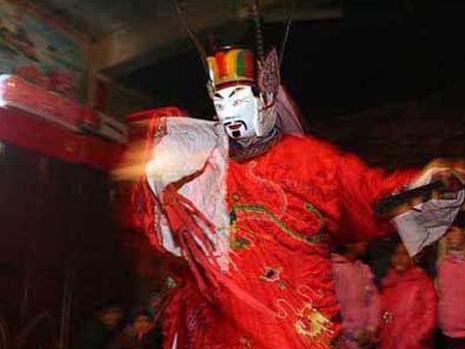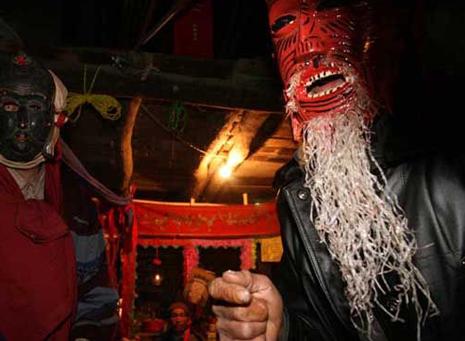
"Wish-Redeeming Dance", called "Feitao" in the Maonan language, is a general term of Maonan's activities related to redeeming a wish or other activities. It was prevalent during the transition from the Ming to Qing Dynasty. The dance was originally a ritual of Maonan to use exorcising opera to offer sacrifice to the heaven, the earth and all natural creatures. During the process when it was passed down generation by generation, it has integrated with oral literature, folksong, drama, dance, music, percussion and other artistic elements of Maonan, and has become a colorful folk activity.
Maonan's "Feitao" has many categories, and it could be expressed in terms of exorcising song, exorcising dance, exorcising music, exorcising tale (lore) and engraving of exorcising face mask. There are a dozen of dancing scenes in "Feitao". When people "redeem a wish", they should put various kinds of "credences", set altar, build a "building" and put up gods' images on the alter. The dancing activity is organized by a group of wizards. When the lead singer wizard asks to invite a god, the wizard representing the god will wear the corresponding mask and dance. They dance to pray to gods for blessing the family who holds the activity and bless the family to prosper for many generations. During the process, the lead singer wizard would say the magic words and sing the sacred book. When he sings a god, the god will dance. They dance in a certain order.

The basic motions of the dance are composed of gentle saluting step, wavy quick short step, throwing sleeve, hand-woven saluting, skips and hops, turning, etc. In the dance, there are few big hopping motions. The dancers skip when moving and the atmosphere is solemn. The gods wear dragon robe and embroidered robe decorated with various colorful patterns and sequins. The goddesses wear clothes and trousers, but not skirts. Their dresses and ornaments are quite similar to those of the ordinary women.





